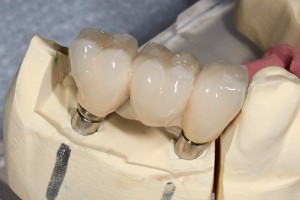Be sure you understand the pros and cons of dental bridges before undergoing treatment.

What Is a Dental Bridge?
A dental bridge typically consists of three attached crowns. The crown in the center replaces your missing tooth. The crowns on either end fit over the teeth adjacent to the gap to hold the replacement tooth in position.
What You Risk By Getting a Bridge
Assuming your dentist has used a quality dental lab to produce your crowns, a dental bridge should look very natural. You should even be able to chew normally using the bridge. However, this restoration is by no means perfect. Some of the most worrisome limitations include:
- Cleaning problems: When a bridge is first placed, you should not have any trouble cleaning it just like your natural teeth. But if the bridge shifts over time, you might end up with a gap between your replacement tooth and your gums that could trap food particles and bacteria, creating a smelly and unhealthy situation.
- Damage to neighboring teeth: Getting a bridge always causes damage to neighboring teeth, because these teeth must be shaved down into pegs to accommodate their crowns and anchor your replacement tooth. If these pegs suffer additional damage due to tooth decay or gum disease, they may become so weak that they can no longer support a bridge. In this case the existing bridge may fail, and you may not be able to get a new one. Instead, you might have to use a partial denture.
- Bone loss: The crown in the center of your bridge only replaces the top portion of your missing tooth, not the root. This means there is nothing stimulating the bone in the area of the missing tooth, and it will begin to lose density. This bone loss can cause other teeth to become unstable, and if the bone loss progresses too far, you might lose your opportunity to ever get a dental implant to replace your missing tooth.
Given all these issues you might wonder…
…why on earth would anyone get a dental bridge?
People are still getting dental bridges because they provide a fast and affordable way to replace a missing tooth. The bridge can be placed in just two visits with virtually no recovery time, and most dental insurance plans will cover a significant portion of the cost. Dental implants, on the other hand, require a long, drawn-out procedure sometimes involving multiple surgeries. Insurance coverage for implants is typically poor, and some individuals are not even eligible for this treatment due to health concerns.
Want More Information?
If you would like to learn more about your options for replacing missing teeth, please contact California Dental Group and make an appointment with one of our experienced dentists.

